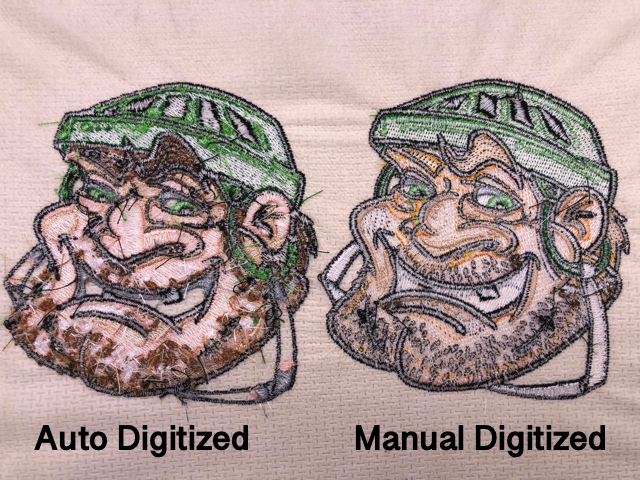High-Quality Digitizing for Embroidery: Expert Craftsmanship
High-Quality Digitizing for Embroidery: Expert Craftsmanship
Blog Article
Streamlining the Art of Embroidery Digitizing: Step-by-Step Overview
Needlework digitizing is a meticulous craft that demands precision and imagination. As technology proceeds to advancement, the digitization procedure has actually ended up being extra accessible, permitting lovers to bring their detailed styles to life with simplicity. In this overview, we will certainly untangle the complexities of embroidery digitizing, damaging down each step methodically to streamline the procedure and empower both beginners and seasoned embroiderers alike. Stay tuned to uncover how you can simplify this detailed art kind and change your innovative visions right into perfectly embroidered masterpieces.
Recognizing Needlework Digitizing Software
Needlework digitizing software program functions as an essential device for transforming intricate styles right into electronic styles compatible with embroidery machines, assisting in accurate stitching and customization. This specific software permits users to import different picture data styles, such as JPG or PNG, and transform them right into embroidery machine-readable layouts like DST, EXP, or PES - Digitizing for Embroidery. By using functions like stitch editing, padding options, and thread color option, digitizing software enables users to control every aspect of the design process
Additionally, progressed embroidery digitizing software application offers tools for developing complex styles, changing stitch thickness, and integrating intricate information. Users can additionally preview the design before sewing it out, ensuring accuracy and reducing errors. In addition, several software application supply automated functions that aid simplify the digitizing process, saving time and effort.
Recognizing the capabilities of needlework digitizing software program is important for accomplishing high-quality outcomes in needlework jobs. By grasping this tool, needlework enthusiasts and professionals can unleash their imagination and bring detailed layouts to life with accuracy and efficiency.

Picking the Right Layout Documents
After acquainting on your own with the capabilities of embroidery digitizing software application, the following critical action in the procedure is choosing the best design declare your task. Digitizing for Embroidery. When selecting a layout declare embroidery digitizing, it's necessary to take into consideration the complexity of the style, the size of the end product, and the kind of textile you will certainly be functioning with
For complex layouts with fine details, a high-resolution picture or vector file is recommended to make sure that the embroidery machine can properly reproduce the layout. Furthermore, the size of the end product plays a considerable duty in choosing the ideal layout file. Bigger designs might require higher resolution files to keep clarity and intensity.
In addition, the kind of material you will certainly be embroidering on influences the choice of layout documents. Different fabrics might call for changes in the style data to make certain that the stitches are properly straightened and the design shows up as meant. By thoroughly choosing the appropriate style file based upon these elements, you can set on your own up for a successful embroidery digitizing process.
Digitizing Devices and Techniques
Using specialized software application and precision strategies, digitizing tools are vital in transforming detailed layouts into site link embroidery-ready data. Embroidery digitizing software program, such as Wilcom, Hatch, or Embrilliance, gives the required system to transform artwork right into stitch information. These programs offer functions like stitch editing and enhancing, underlay choices, and text devices to make sure the style converts flawlessly onto material.
Among the vital methods in digitizing is developing a clear course for the needlework equipment to comply with. This entails digitizing each component of the design with accuracy, establishing stitch types, densities, and directions. By utilizing tools like digitizing tablets or software-specific plugins, embroiderers can achieve a high level of accuracy in their digitized layouts.
In addition, grasping the art of rug sewing is vital for creating top quality embroidery. Underlay stitching maintains the material and creates a structure for the layout, making certain that the last product is both aesthetically appealing this and resilient. By comprehending these digitizing devices and methods, embroiderers can boost their craft and bring elaborate layouts to life with accuracy and effectiveness.
Personalizing Stitch Types and Directions
The selection of stitch types can dramatically influence the total look and appearance of the embroidered design. By purposefully incorporating these stitch types, embroiderers can achieve deepness and dimension in their designs.
Additionally, the instructions of stitches plays a crucial function in boosting the aesthetic charm of the final needlework. By experimenting with different stitch angles and patterns, embroiderers can bring their designs to life with impressive information and ins and out.
Screening and Refining Your Digitized Style
To ensure the precision and quality of your digitized layout, detailed testing and refinement are crucial action in the embroidery digitizing procedure. As soon as you have finished the digitization of your style, it is vital to test it before waging the actual embroidery. Checking permits you to identify any possible problems such as thread breaks, stitch thickness troubles, or design distortions that may influence the result.

After screening, it is necessary to refine your digitized style based upon the responses from the test sew-out. This may involve tweaking stitch setups, readjusting thickness, or making modifications to the total layout to attain the preferred result. By repeating through screening and refinement, you can adjust your digitized style to excellence before relocating onward with the real needlework process.
Conclusion
In final thought, mastering the art of embroidery digitizing needs a thorough understanding of the software program, selecting the best style documents, making use of digitizing devices and techniques, tailoring stitch kinds and directions, and testing and improving the digitized layout. By complying with these steps, embroiderers can simplify the digitizing process and create top notch embroidered styles with accuracy and efficiency.
Report this page